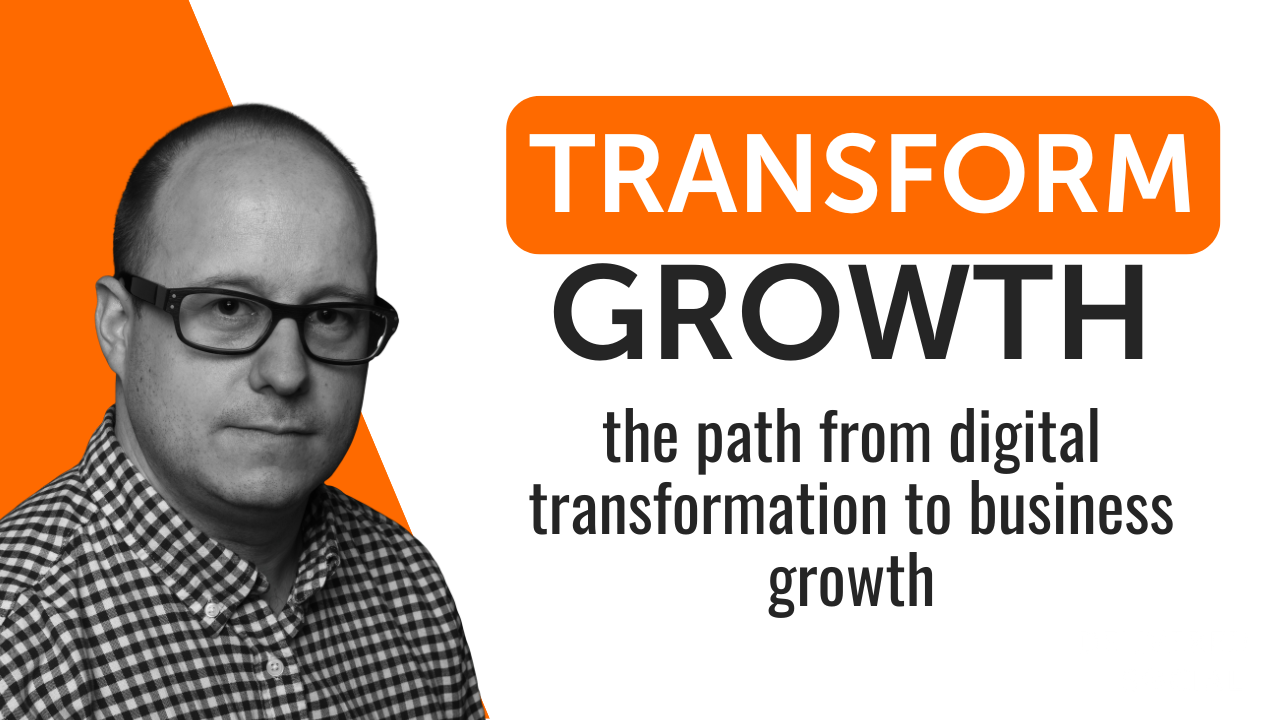
From Digital Transformation to Business Growth: Locus Communis
Digital transformation won’t magically grow your business. It’s infrastructure. It makes the work of growing less painful and more predictable. The idea sounds vague because it can be interpreted in various ways. We’ll focus on the parts that appear in every real transformation project.
The Digital Problem—Stuck in the Middle
Deloitte notes that companies are progressing in digital maturity. Still, many are stuck in a “messy middle” between analog and digital, which generates complexity without delivering expected profit or revenue growth. To truly gain control over this complexity and see real returns, the focus must shift to tangible efficiency gains and optimizing existing technology rather than just acquiring new tools. To achieve the desired result more quickly, it is beneficial to understand the twists and turns at the very beginning of the path.
Zero Level—Digital Transformation Starts
Most businesses think they need AI or cloud platforms. They don’t. They need to stop bleeding money on things a computer could handle better than a human with a spreadsheet. AI-powered business process automation is about catching up.
Manual Work That Shouldn’t Exist
People spend hours every week on work that software solved twenty years ago. A manufacturing company still tracks inventory by walking the warehouse with clipboards. When production needs materials, someone physically checks the shelves, writes the numbers on paper, and then types those numbers into a purchasing system. By the time they place orders, the production schedule has already shifted.
Data That Doesn’t Talk
Sales teams at a logistics company are aware of what clients have ordered, but they can’t view the delivery status. Operations know which trucks are delayed, but can’t access customer contact information to give updates. When clients call asking about their shipments, customer service puts them on hold while someone walks across the building to ask the dispatch office.
Problems That Announce Themselves Too Late
A restaurant chain discovers food cost problems when the monthly Profit and Loss statement is released, three weeks after the waste occurred. By then, they’d lost thousands of dollars on spoiled inventory and could no longer recall which locations had issues or why.
Knowledge That Walks Out the Door
When the office manager at a law firm retires, she takes with her the informal system for tracking case deadlines, client preferences, and vendor relationships. Her replacement spends six months rebuilding institutional knowledge while cases slip through the cracks and clients wonder why service quality has declined.
Speed That Money Can’t Buy
An insurance agency watches clients switch to online competitors who approve applications in minutes instead of days. The bottleneck isn’t in underwriting decisions but rather the time spent moving information between systems that don’t communicate effectively.
The Starting Point—Digital Transformation Investment
When businesses talk about investing in digital transformation, they’re usually thinking about buying software. That’s 30% of what needs to happen. The other 70% involves changing how people work, which is harder, takes longer, and costs more than anyone budgets for. An ERP integration service provider can help with the software part, but not the human resistance.
Technology: The Easy Part
Cloud infrastructure sounds impressive until someone has to migrate fifteen years of data without breaking anything that’s currently working. Moving to the cloud means accepting that other people control when systems get updated, how much they cost, and whether they stay online during critical periods.
AI tools excel in specific, repetitive tasks where the cost of error is low. They fail when context matters, when exceptions are standard, or when the stakes are high. Most businesses discover that AI saves time on tasks that don’t take much time anyway.
Automation platforms eliminate human error by replacing it with system error. A manual process that fails shows you exactly where and why. An automated process that fails might cascade through multiple systems before anyone notices. The error becomes harder to find and more expensive to fix.
Data analytics systems tell you what happened after it happened. They help spot patterns and measure changes, but they don’t predict the future or make decisions for you. Someone still has to interpret the data and decide what to do about it.
Cybersecurity costs more every year and still doesn’t guarantee protection. It’s insurance against some risks while creating new dependencies on security vendors, software updates, and employee compliance.
Processes: The Hard Part
Redesigning workflows sounds logical until you discover why the current workflow exists in the first place. That seemingly inefficient step might be catching errors. That redundant approval might be preventing fraud. That manual check might be the only thing keeping customers happy.
Breaking down departmental silos often means breaking down accountability. When everyone is responsible for something, no one is responsible for it. Departments exist partly because different functions require different expertise, different priorities, and different measures of success.
End-to-end process design assumes you understand the entire end-to-end process. Most businesses don’t. They discover missing steps, hidden dependencies, and informal workarounds only after the new system goes live and things start breaking.
People: The Unpredictable Part
Training people on new tools works when the tools make their jobs easier. When the tools add complexity, require more steps, or create new ways to make mistakes, training becomes an ongoing expense rather than a one-time investment. Building teams that adapt quickly means hiring people who are comfortable with constant change and uncertainty. These people cost more, expect more autonomy, and leave when they find better opportunities. The teams that adapt best are often the least loyal.
What The Investment Buys
Digital transformation investment buys you the ability to handle growth without proportionally increasing costs. Instead of hiring five people to process twice as many orders, you might hire two people and spend the difference on software licenses. It buys you a faster response to changes, but not necessarily better responses. You can adjust prices, inventory, or staffing more quickly when you have real-time information, but you still have to make the proper adjustments. It gives you competitive parity in markets where digital capabilities have become a must-have. You’re not gaining an advantage; you’re avoiding a disadvantage.
Direct Results of Digital Transformation Investment
When digital transformation is effective, the changes are evident in predictable areas. Not revolutionary breakthroughs but measurable improvements in how work gets done.
Enhanced Efficiency
People stop spending their mornings copying information from one system to another. A trucking company eliminates the daily ritual of drivers calling dispatch to report their location—GPS tracking handles it automatically. Approvals that used to take three days happen in three hours because documents move through digital workflows instead of sitting on desks. Error rates drop when systems enforce consistency rather than relying on human memory. Efficiency gains hit a ceiling, though. You can only automate so much before you need human judgment. The remaining inefficiencies often exist for reasons that become clear only when you try to eliminate them.
Improved Customer Experience
Customers receive accurate information when they ask for it, rather than being told, “Let me check and call you back.” Response times improve because the correct information reaches the right person faster.
Problems get caught before customers notice them. A software company monitors system performance and fixes issues during low-traffic periods instead of waiting for complaints.
Customer experience improvements are practical until they aren’t. Automated systems handle routine requests well but fail badly when something unusual happens. The streamlined digital experience often makes it harder to reach a human who can solve complex problems.
Faster Innovation Cycle
Development cycles shrink when teams can test ideas without having to build entire systems from scratch. Market feedback arrives faster because digital channels provide immediate data on customer behavior. Resource allocation becomes more responsive when managers can see real-time performance data instead of waiting for quarterly reviews.
Faster innovation cycles create their own problems. Teams can test more ideas, but most of them are still flawed. The speed of failure increases along with the speed of success. Organizations unprepared for higher rates of change often find that faster innovation creates more chaos than value.
The Link to Business Performance—Competitive Impact
The operational changes begin to affect how you compete. Money that used to disappear into inefficiency stays in your pocket, and customers notice the difference.
Cost Reduction: Labor costs drop when fewer people can handle the same workload, and waste decreases when systems catch problems before they become expensive. These savings go straight to profit margins, giving you room to either undercut competitors or invest in growth while they’re still paying for inefficiency.
Increased Customer Loyalty & Retention: Customers sticking around when dealing with you becomes easier and more predictable than dealing with your competitors. The cost of keeping existing customers drops while their lifetime value increases, which means you can spend less on advertising and more on improving what you deliver.
Expanded Market Reach: Digital channels let you sell to people who would never have found you through traditional methods, and personalized marketing helps you speak to customer segments that your old broad-brush approach missed. Geographic expansion becomes possible without opening physical locations, though you still need to understand local markets and regulations.
New Revenue Streams: Faster development cycles mean you can test new products and services before competitors even realize there’s an opportunity. The revenue streams that work best combine your existing expertise with digital delivery methods rather than completely reinventing what you do.
Enhanced Brand Reputation: Being known as a company that has its act together attracts customers who are tired of dealing with businesses that waste their time. It also helps you recruit better employees, though maintaining that reputation requires consistently delivering on the expectations you create.
The Ultimate Result—Business Growth
The competitive advantages eventually show up in numbers that matter to anyone who owns or runs a business. Growth occurs when operational improvements compound over time rather than being offset by new inefficiencies. Not every digital transformation reaches this stage, but those that do create a measurable distance between themselves and competitors who are still fighting fires.
Increased Revenue
- Existing customers spend more because the experience doesn’t frustrate them, and cross-selling becomes easier when systems can identify what they need
- New customers find the business through digital channels and convert at higher rates because the sales process works smoothly, instead of creating barriers
- Digital products or services generate income streams that don’t require proportional increases in labor or physical infrastructure
Higher Profit Margins
- Operational costs stay flat or decrease while revenue grows, creating the margin expansion that lets businesses reinvest in growth rather than just survival
- Customer acquisition becomes more efficient when referrals increase, and digital channels cost less than traditional advertising
- Pricing power improves when the service experience justifies premium rates compared to competitors who still operate like it’s 1995
Greater Market Share
- Price competition becomes winnable when cost structure improvements allow for lower prices without sacrificing quality or service
- Customer experience advantages create switching costs for competitors’ customers who get tired of dealing with businesses that waste their time
- Speed advantages in product development mean capturing market opportunities before slower competitors even recognize they exist
Sustainable Competitive Advantage
- Competitors face higher barriers to entry because matching the operational efficiency requires years of investment and organizational change; they may not survive
- Business model resilience increases when multiple revenue streams and faster adaptation cycles reduce dependence on any single market condition
- The gap widens over time as digital capabilities enable faster responses to changes while competitors remain locked into slower, more expensive operating methods
Digital Transformation Is the Long Game
Digital transformation typically takes two to three years before the real payoff is realized. That is why most businesses quit halfway through when the disruption feels worse than the problems they started with. The first year is usually more challenging as people learn new systems and processes break in unexpected ways. Year two is when efficiency gains start to outweigh the chaos, but competitors can still match most of what gets accomplished. By year three, the compound effects kick in—cost advantages, customer loyalty, and operational speed create gaps that take competitors years to close, even if they start immediately. The businesses that stick with it end up with profit margins and growth rates that make the initial investment look trivial.
Interested In Working Together?
Introducing Delivered Social. We’re The Most-Rated Digital Agency In Surrey & Hampshire – We’ve Got To Be Doing Something Right.
Delivered Social is a digital marketing agency with one mission—to help businesses grow. We’re famous in Guildford and Portsmouth for our social clinics. We believe in free advice. We build lasting relationships because our team prides itself on being helpful, which our clients appreciate.
If you are looking for a new website or an agency to manage your social media presence, we can help.
If you need something slightly different, here's a super handy list of all our services, or you can always email us.























